Dept. Heaven | Knights in the Nightmare
Dept. Heaven resource post series, part 4! This is about Episode IV in the series, Knights in the Nightmare.
The masterpost can be found here!
Warning: This post is image-heavy.

Knights in the Nightmare is Episode IV of Dept. Heaven. It was first released on the Nintendo DS in 2008, and was reworked for the PSP in 2010. Kiyudzuki Satoko served as character designer and art director, while Tobe Sunaho drew most of the final character portraits and Iwanaga Yoshinori drew the final monster art. The PSP version features a bonus third storyline that was left on the drawing room floor during DS production.
The Story
There was once an island kingdom called Gleivnir, ruled by a wise king named Willimgard and protected by an army of brave knights. The kingdom was built around a thousand-year-old castle called Aventheim, said to have been created by a great sage. Because the castle has changed hands numerous times over the centuries, there are several different races and cultures that call the kingdom their home-and the class divides are very severe. Recent sovereigns like Willimgard have attempted to reintegrate society and make class mobility possible, but there are still tensions between the nobility descended from immigrants and the peasants descended from the indigenous people.
No one knows when things started going wrong. Perhaps it was when the tower of the Tiamat and Lemonoug peoples was destroyed by lightning, and Asgard refused to hear their pleas for help. Perhaps it was when the king’s political rival, Cardinal Capehornus, started sending the knights and the king himself out to the far reaches of the kingdom based on rumors of unrest. The only sure thing is that one day the kingdom was invaded by terrifying monsters, and that when the king returned to his castle he was murdered by a mysterious assailant.
As the kingdom grieved and prepared to bury their lord, a mysterious valkyrie stole the crucible that held Willimgard’s soul. Running far from the castle and the knights who pursued her, she released the soul-the Wisp-calling it the “Arbitrator” and asking for its help in accomplishing her own personal objective.
Knights in the Nightmare is a dark, baroque story influenced by Dante Alighieri’s Divine Comedy, woven together from many complex strands. It’s a story about pushing forward in the face of despair, about sin and punishment and taking responsibility, about not being able to turn back, and about the strength of the bonds between people.
The Characters
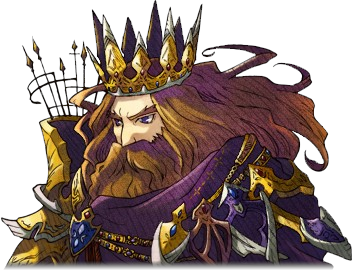
Willimgard Ron Dragan D’Gleivnir / Wilmgard is the protagonist, the current king of the Gleivnir Knight Kingdom, a generally popular ruler and famed warrior known as the Lionhearted King. After a mysterious attack, he is reduced to a Wisp of soul with no memories or conscious mind. He heads toward his castle in search of his body, so that he might return to life.
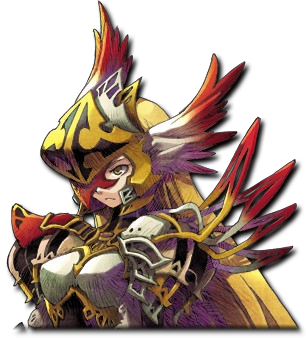
Maria is one of the heroines of the game, a mysterious valkyrie dressed in gold. She frees the Wisp, seeking its help to fight off the monsters and recover something that she has lost. Actually somewhat timid and lacking in self-confidence despite her statuesque appearance. Feels responsible for the tragedy at Aventheim.
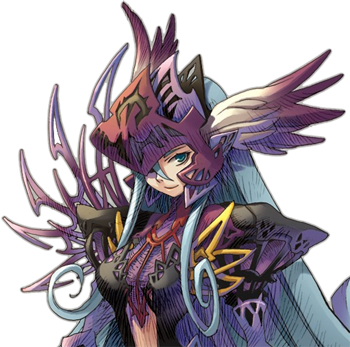
Mellia / Meria is one of the heroines of the game, a mysterious valkyrie dressed in black. She frees the Wisp, seeking its help in settling her accounts with a certain enemy. Very irreverent, rude, and cheerful. Does what she wants; cannot be shamed or tamed. Has double middle fingers and a very spiky sword for anyone that tries to tell her what to do.
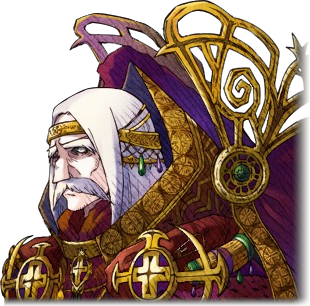
Capehornus Mirza Lucius / Capehorn is the cardinal of the kingdom, and head of a political faction opposing the king’s. He’s clearly up to no good, but seems to have his hands full with his disobedient subordinates.
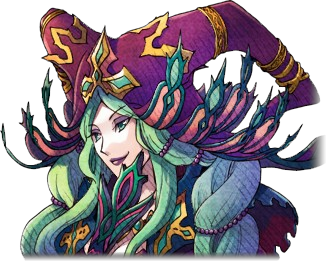
Yellma Ul Varomone / Yelma is one of Capehornus’ soldiers, a talented witch from a lower middle class background who got into the army based on her skills alone. Also clearly up to no good, she doesn’t care much about what her orders are, and seems to have her own designs separate from Capehornus’.
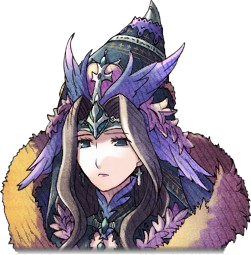
Alighierie Mirza Ector / Algiery is one of Willimgard’s generals, and is rumored to be his lover. She has a devoted following amongst the knights, but has gone missing after having been accused of murdering the king.
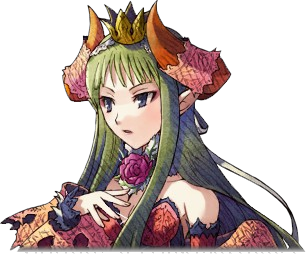
Arlier Ciel Graceheize / Alier is the princess of the oppressed Tiamat race. She has a better grasp on the situation than most thanks to her people’s lore, and knowing that no one in the world will escape the consequences of the king’s death, tries to act so that her people might survive.
The Format
Knights in the Nightmare is a strategy RPG. By the way, take everything you know about that genre and pitch it out the window right now, because this game is nothing if not Ito flipping off genre conventions.
The game plays like real-time chess infused with bullet hell elements: In each isometric stage of the game, you-the Wisp-must deploy a handful of your soulless knights and use them to attack monsters. Rather than aiming at your corpse collection, though, the monsters will be aiming for your shiny Wispy cursor, attacking via brightly-colored bullets that you must evade. You start each stage with a certain amount of time on your clock, which depletes with every attack you make and every hit you suffer. When you run out of time, your turn ends. If you can’t defeat a certain number of monsters/the boss before you’re out of turns, it’s game over.
Now let’s talk a little bit about units in specific. You must recruit knights manually by handing them certain items, which can be found by destroying objects around every stage. There are a lot of knights to obtain-115 in total, counting the guest character who appears if you’ve got Yggdra Union in your GBA slot/save data on your memory card. This is because your knights are only usable for as long as they have VIT remaining, VIT depletes every time you attack with a unit, and when it runs out your units permadie. VIT restores when units level up, but all units have a level cap.
There’s a way around this level cap, though: The Transoul system, through which you can sacrifice one unit to power up another. The bonuses that are earned through Transoul are different depending on the relationship between the two units involved, and Transoul itself is completely optional.
There are seven classes of unit, and they all attack in different ways using different weapons. Figuring out which classes are the most useful in each situation is the key to mastering the game.
By the way, your heroine is a special case: She can use any weapon and can move in any direction, and has access to super-powerful techniques, but she has only 7.77 VIT to use per map. If she dies, it’s game over, so use her wisely.
If all this seems hopelessly confusing, you’re in luck-there’s a detailed step-by-step tutorial included in the game that you can look at before you start, with addendums on the finer points of the game system included.
The way the story is told is also worth mentioning: Each map begins with a story scene about things that are happening in the present all over the country, and ends with a flashback that took place in the same spot as your battle. Flashbacks are always given with a rough date (X days before/after X event).
Too, once you complete the first route with Maria, you will unlock a second route with a new heroine. This second route features many knights to recruit that don’t appear in Maria’s route, a few different story scenes, and an interesting shift between two main characters that has a huge influence on how the story plays out. Every route has multiple endings based on a few hidden conditions and whether or not you can win the final battle. Utilizing the New Game Plus function will also allow you to keep the knights you finished the game with; this is the only way to collect all 115 knights at once.
There are four difficulty levels in the game. The latter two, Hard Mode and Nightmare Mode, must be unlocked via completing the difficulty level before them. Each mode changes the number of enemies you must defeat to clear a stage, the VIT cost of attacking, how much EXP you get, the size of enemy bullets, and whether or not you can access the Leveling function to grab extra EXP with no cost. Difficulty level has no effect on the story and recruitable characters.
Knights in the Nightmare is very heavily tailored to the DS, so there are a few functions that became slightly awkward in the PSP version. However, said PSP version has a few pieces of new content available-a bonus gag storyline featuring Yggdra as the heroine, which had originally been planned for the DS version but was cut; and a catalogue of all the Pause Talk dialogue (talking to onscreen characters by pausing when the cursor is on them) you have viewed.
Extra Materials
Knights in the Nightmare: The Official Guide - Contains an interview with the game staff, and various art assets.
Dept. Heaven World Guidance - Contains art, staff interviews, worldbuilding and backstory discussion, and an official timeline.
The masterpost can be found here!
Warning: This post is image-heavy.
Knights in the Nightmare is Episode IV of Dept. Heaven. It was first released on the Nintendo DS in 2008, and was reworked for the PSP in 2010. Kiyudzuki Satoko served as character designer and art director, while Tobe Sunaho drew most of the final character portraits and Iwanaga Yoshinori drew the final monster art. The PSP version features a bonus third storyline that was left on the drawing room floor during DS production.
The Story
There was once an island kingdom called Gleivnir, ruled by a wise king named Willimgard and protected by an army of brave knights. The kingdom was built around a thousand-year-old castle called Aventheim, said to have been created by a great sage. Because the castle has changed hands numerous times over the centuries, there are several different races and cultures that call the kingdom their home-and the class divides are very severe. Recent sovereigns like Willimgard have attempted to reintegrate society and make class mobility possible, but there are still tensions between the nobility descended from immigrants and the peasants descended from the indigenous people.
No one knows when things started going wrong. Perhaps it was when the tower of the Tiamat and Lemonoug peoples was destroyed by lightning, and Asgard refused to hear their pleas for help. Perhaps it was when the king’s political rival, Cardinal Capehornus, started sending the knights and the king himself out to the far reaches of the kingdom based on rumors of unrest. The only sure thing is that one day the kingdom was invaded by terrifying monsters, and that when the king returned to his castle he was murdered by a mysterious assailant.
As the kingdom grieved and prepared to bury their lord, a mysterious valkyrie stole the crucible that held Willimgard’s soul. Running far from the castle and the knights who pursued her, she released the soul-the Wisp-calling it the “Arbitrator” and asking for its help in accomplishing her own personal objective.
Knights in the Nightmare is a dark, baroque story influenced by Dante Alighieri’s Divine Comedy, woven together from many complex strands. It’s a story about pushing forward in the face of despair, about sin and punishment and taking responsibility, about not being able to turn back, and about the strength of the bonds between people.
The Characters
Willimgard Ron Dragan D’Gleivnir / Wilmgard is the protagonist, the current king of the Gleivnir Knight Kingdom, a generally popular ruler and famed warrior known as the Lionhearted King. After a mysterious attack, he is reduced to a Wisp of soul with no memories or conscious mind. He heads toward his castle in search of his body, so that he might return to life.
Maria is one of the heroines of the game, a mysterious valkyrie dressed in gold. She frees the Wisp, seeking its help to fight off the monsters and recover something that she has lost. Actually somewhat timid and lacking in self-confidence despite her statuesque appearance. Feels responsible for the tragedy at Aventheim.
Mellia / Meria is one of the heroines of the game, a mysterious valkyrie dressed in black. She frees the Wisp, seeking its help in settling her accounts with a certain enemy. Very irreverent, rude, and cheerful. Does what she wants; cannot be shamed or tamed. Has double middle fingers and a very spiky sword for anyone that tries to tell her what to do.
Capehornus Mirza Lucius / Capehorn is the cardinal of the kingdom, and head of a political faction opposing the king’s. He’s clearly up to no good, but seems to have his hands full with his disobedient subordinates.
Yellma Ul Varomone / Yelma is one of Capehornus’ soldiers, a talented witch from a lower middle class background who got into the army based on her skills alone. Also clearly up to no good, she doesn’t care much about what her orders are, and seems to have her own designs separate from Capehornus’.
Alighierie Mirza Ector / Algiery is one of Willimgard’s generals, and is rumored to be his lover. She has a devoted following amongst the knights, but has gone missing after having been accused of murdering the king.
Arlier Ciel Graceheize / Alier is the princess of the oppressed Tiamat race. She has a better grasp on the situation than most thanks to her people’s lore, and knowing that no one in the world will escape the consequences of the king’s death, tries to act so that her people might survive.
The Format
Knights in the Nightmare is a strategy RPG. By the way, take everything you know about that genre and pitch it out the window right now, because this game is nothing if not Ito flipping off genre conventions.
The game plays like real-time chess infused with bullet hell elements: In each isometric stage of the game, you-the Wisp-must deploy a handful of your soulless knights and use them to attack monsters. Rather than aiming at your corpse collection, though, the monsters will be aiming for your shiny Wispy cursor, attacking via brightly-colored bullets that you must evade. You start each stage with a certain amount of time on your clock, which depletes with every attack you make and every hit you suffer. When you run out of time, your turn ends. If you can’t defeat a certain number of monsters/the boss before you’re out of turns, it’s game over.
Now let’s talk a little bit about units in specific. You must recruit knights manually by handing them certain items, which can be found by destroying objects around every stage. There are a lot of knights to obtain-115 in total, counting the guest character who appears if you’ve got Yggdra Union in your GBA slot/save data on your memory card. This is because your knights are only usable for as long as they have VIT remaining, VIT depletes every time you attack with a unit, and when it runs out your units permadie. VIT restores when units level up, but all units have a level cap.
There’s a way around this level cap, though: The Transoul system, through which you can sacrifice one unit to power up another. The bonuses that are earned through Transoul are different depending on the relationship between the two units involved, and Transoul itself is completely optional.
There are seven classes of unit, and they all attack in different ways using different weapons. Figuring out which classes are the most useful in each situation is the key to mastering the game.
By the way, your heroine is a special case: She can use any weapon and can move in any direction, and has access to super-powerful techniques, but she has only 7.77 VIT to use per map. If she dies, it’s game over, so use her wisely.
If all this seems hopelessly confusing, you’re in luck-there’s a detailed step-by-step tutorial included in the game that you can look at before you start, with addendums on the finer points of the game system included.
The way the story is told is also worth mentioning: Each map begins with a story scene about things that are happening in the present all over the country, and ends with a flashback that took place in the same spot as your battle. Flashbacks are always given with a rough date (X days before/after X event).
Too, once you complete the first route with Maria, you will unlock a second route with a new heroine. This second route features many knights to recruit that don’t appear in Maria’s route, a few different story scenes, and an interesting shift between two main characters that has a huge influence on how the story plays out. Every route has multiple endings based on a few hidden conditions and whether or not you can win the final battle. Utilizing the New Game Plus function will also allow you to keep the knights you finished the game with; this is the only way to collect all 115 knights at once.
There are four difficulty levels in the game. The latter two, Hard Mode and Nightmare Mode, must be unlocked via completing the difficulty level before them. Each mode changes the number of enemies you must defeat to clear a stage, the VIT cost of attacking, how much EXP you get, the size of enemy bullets, and whether or not you can access the Leveling function to grab extra EXP with no cost. Difficulty level has no effect on the story and recruitable characters.
Knights in the Nightmare is very heavily tailored to the DS, so there are a few functions that became slightly awkward in the PSP version. However, said PSP version has a few pieces of new content available-a bonus gag storyline featuring Yggdra as the heroine, which had originally been planned for the DS version but was cut; and a catalogue of all the Pause Talk dialogue (talking to onscreen characters by pausing when the cursor is on them) you have viewed.
Extra Materials
Knights in the Nightmare: The Official Guide - Contains an interview with the game staff, and various art assets.
Dept. Heaven World Guidance - Contains art, staff interviews, worldbuilding and backstory discussion, and an official timeline.